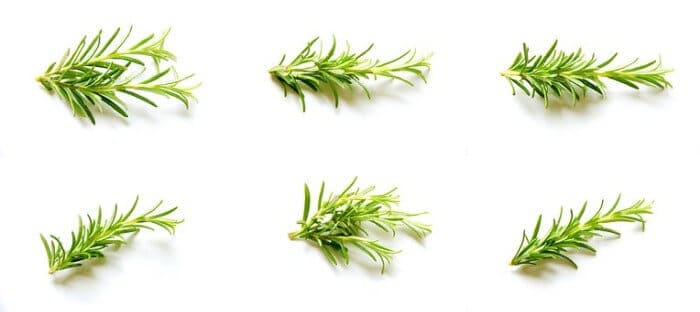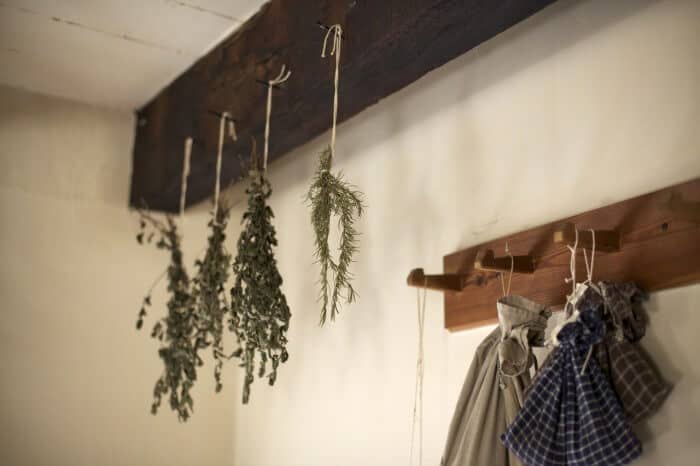Rosemary (Rosemarinus officinalis) originates from the Mediterranean region but can be successfully grown around the world given the right conditions.
This perennial is fairly hardy and will reward you with aromatic leaves to use in your cuisine ranging from roast lamb to soups, poultry and casseroles. Keep cutting off small twigs – a little goes a long way as the flavor is quite intense – to add to dishes and it will simply grow bushier!
The plant has small blue flowers which bees find attractive. If it starts flowering leave them be – they are busy collecting pollen and are unlikely to sting. Some people suggest keeping bees away from the rosemary by cutting off the flowering tips but considering the fact that the bee population is under threat we should give bees every chance to collect nectar and do their valuable work in pollinating crops.
Here are some tips and tricks to planting, growing and harvesting rosemary successfully.

Soil
Rosemary likes a well-drained soil that gets full sun with a minimum temperature of 70 F (21 C) for successful growth. The soil can be sandy or loamy and for best results should be slightly acid – around pH 6-7.
The name rosemarinus means dew or mist of the sea, and where rosemary has grown for thousands of years around the coast of the Mediterranean it has adapted to fairly poor soil, clinging into crevices between rocky outcrops that are fairly steep, and tolerating the slightly salty sea breezes. It does not like soggy roots – when it rains the soil should drain quite quickly.
Aim to put it in drier areas of the garden where it won’t mind a breeze and soil that can dry out between watering or rain.
What variety should I choose – upright or vining?
This is very much an individual choice – some people prefer the upright varieties because they are tidier in growth while other people like the fact that they can put the vining type into a container or hanging basket where it will trail prettily while still providing leaves for cooking.
- Common Rosemary –this is the variety you are going to come across at most nurseries or garden centers. It grows from 2 to 4 feet tall and has fairly pale blue flowers.
- Salem Rosemary – this is an upright growing plant that spreads to around 3 feet tall and 3 feet across. The woody stems are useful as skewers for shish kebabs.
- Spice Island Rosemary has a pungent flavor – a little goes a long way on this upright variety that grows 2 to 2 ½ feet tall.
- Blue Boy Rosemary – this variety is quite small – ideal for planting in the front of low borders or as a container plant and is quite hardy. Looked after properly it will last for years, as will your other rosemary plants.
- Prostrate Rosemary – the name says it all – it likes to lie down and is a vining type, but it still gets quite large – up to 3 feet tall and can spread out to between 4 and 8 feet and is more often used in landscaping than cooking.
- Hardy Hill is a very popular upright variety that will survive a warm winter and is popular in the US.
- Arp is also a variety that is winter hardy
- Tuscan Blue has dark blue flowers and is very fragrant.
It is best to go to your local nursery if you want to introduce rosemary to your herb garden, and ask for advice on a plant that is suited to your growing region..

Planting
Rosemary is planted from fingerlings – shoots the length of a finger with a pliable greenish stem – you won’t get success from choosing hard woody stems. Simply cut them off the main plant, about an inch from where they join a larger stem. Sometimes I just pull them off – but that‘s when I suddenly decide to root a few while walking around the garden and don’t have secateurs at hand.
Put them in pots with a good potting soil after removing about a third of the length of the fingerlings lower leaves – it just gives the plant less work to do in trying to feed all the leaves and they just seem to keep growing if you plant them an inch deep.
Rosemary can be planted from seed but this is not a popular method. By taking cuttings from the mother plant you are sure of the type of hardiness, growth pattern and intensity of aroma of the new plants.
At one stage I used hormone rooting powder because that was the current advice, but it didn’t really make a difference – they all mostly grew anyway whether the hormone rooting powder was used or not.
The only time some died was if they weren’t kept moist enough as they were creating their new root system. In windy weather the soil dries out quickly, so give them more water – whether they are in pots or the ground.
Some people start their rosemary fingerlings in jars of water – just put the third that has been stripped of leaves in a jar with sufficient water to cover that third and keep changing every few days and you’ll see new roots developing.
My opinion is that the plant is getting a double dose of shock – being ‘planted’ into water and then moved to soil – I prefer one shock – from cutting straight to soil. Within 2 months you’ll be able to pick a few leaves from your new plants!
Remember to space them well in the garden as they can grow around 4 feet tall and up to 4 feet across. They do well in keeping away pesky insects so are a good companion plant for cabbages, carrots and beans.
Growing Rosemary Indoors
While you can start rosemary plants indoors they can be little difficult to maintain in peak condition indoors. They will be happier on a sunny patio as they like a bit of a breeze. Around the Mediterranean they grow on the hillsides and in gardens that catch a sea breeze and air circulation is important for plant health.
Although they can survive temperatures of down to 30 degrees Fahrenheit outside, the indoor temperature that suits them best is around 50 to 80 degrees Fahrenheit. Powdery mildew can be a problem indoors. Due to lack of air circulation.
Rosemary grown in containers can become root bound so you will need to repot when you notice the lower leaves turning yellow. Plants indoors can get brown tips more easily than outdoors – this is a sign of root rot and you will need to make sure the container and soil drains well – also that the drip tray is not in direct contact with the base of the pot.
The tips can also go brown when you bring containers inside for over-wintering due to the change in environment.
Whereas in the garden rosemary is quite drought tolerant this is simply because the roots can really spread out and get the moisture then need from the soil – in a container they are confined and more dependent on getting moisture regularly.
Watering
The secret with rosemary is not to give the plants too much water – they need to be kept moist for the first couple of weeks after planting – when you see that they are not shriveling and drying up so you know they have rooted. After that water them every second day or when you see the soil at the base of the plant is dry.
The problem with rosemary being evergreen is that the leaves won’t wilt like other plants immediately alerting you to the fact that they need water – once you see the tips turning brown then it may already be too late to save them.
When to Plant
Plant in spring after the last frosts. In warmer climates this evergreen perennial will keep going all year providing twigs for cooking, acting as an insect repellant and giving off a delicious aroma when the leaves are rubbed.
Over-Wintering
In cooler climates you may want to plant in containers and move them indoors when the first frosts are on the way. When kept indoors there are few things to keep in mind – air is frequently less humid indoors and the plants may need misting daily if heating makes the air dry.
They still need plenty of sun so should be placed at a south facing window. If moving the large plants indoors is too much trouble then take some cuttings and get them started indoors and they will be ready for the next season once the soil warms up and they can be transplanted outdoors.
Pest and Diseases
- Aphids: These can be dislodged with a strong spray of water from a hose. You can then dust the plants with flour if you really need to. People use dishwashing soap and lemon juice mixed with water as a spray for aphids and whitefly but if you’re going to be picking leaves daily I wouldn’t be too keen on the idea of dish soap residue.
- Powdery Mildew: This occurs when there isn’t enough air circulation and often occurs ore frequently when plants are indoors and the air temperature is around 60-80 degrees Fahrenheit. It can also occur outdoors is plants are packed too tightly with other plants in borders. It can be controlled using a fungicide – but don’t pick twigs from the plant until safe according to the recommendations on the fungicide container.
- Root Rot: If you are in an area that gets high rainfall make sure the soil is well-drained so they don’t get root rot, which is a fungal infection that can’t be fixed. To avoid this make sure your plant is well drained otherwise the leaves will turn brown, and once it has set in that is the end of the plant. If you overwater indoors they are at risk of root rot – especially if the drip tray beneath them is in contact with the base of the pot so make sure there is a gap, by placing small pieces
- Spit bugs: You’ll notice the whitish balls of a spit like substance surrounding the small brown insects that feed on the sap of the plant. If the plant is heavily infested they will affect its growth but they are not usually a problem. A good hose down with water paying attention to the area infected should get rid of them.
- Whitefly: Blast off these pests with a spray from the garden hose then for those that may remain hang up yellow pieces of card smeared with Vaseline near your plants – they like the color and will get stuck on the Vaseline and die.
10 Other Uses for Rosemary
- An infusion made by pouring boiling water over fresh rosemary leaves then straining provides a hair rinse that makes hair soft and shiny, it is also said to help control dandruff and encourage hair growth.
- To keep insects away from patio areas plant rosemary in containers along with other containers filled with lemon grass to deter pesky mosquitoes and flies.
- A bunch of rosemary in a vase in the kitchen will also keep the area relatively free of flies.
- Crushed rosemary with some coarse salt crystals provides a relaxing addition to a bath.
- Drinking rosemary tea improves cognitive performance and memory according to research published in the Journal of Psychopharmacology.
- Create exotic oils and vinegars for cooking by adding a sprig of fresh rosemary to sunflower, olive oil, or vinegar, and leave in a sunny spot for a few days to infuse the flavor. It can also be used chopped up to make rosemary butter or if you want to be more exotic mix the little blue flowers into your butter.
- Little pouches of dried leaves sewn into muslin or other pretty fabric will keep drawers and cupboards smelling fresh and deter moths.
- Add dried rosemary cuttings to the fireplace for a delicious aroma in winter or when barbequing on a patio in summer to flavor the meat and repel insects.
- Relieve congestion by adding fresh rosemary leaves to hot water and steaming. Also add some rosemary to the water if you are steaming your face to clear blocked pores.
- The woody stems can be used as skewers for kebabs.

Harvesting
While you will be cutting your rosemary as you need during the spring and summer, you may also want to preserve some rosemary for the winter season.
Cut a bunch of twigs and hang up to dry in a well ventilated spot that is relatively dust free. Once completely dry strip the leaves and keep in jars to add to cuisine. Also keep some bunches whole, ready to add to winter fires.
An alternative if you don’t have much space is to put small quantities of rosemary in a brown paper lunch bag in the fridge – keep checking that it is not getting moldy – but it should dry out well and you’ll have rosemary to add to those delicious garlicky roast potatoes, warm winter casseroles and soups.


As a child I wanted to grow up and marry a farmer… simply because it was so different from my life right on the shores of the ocean. Well, I didn’t marry a farmer but a surfer instead. The urge, however, to grow stuff and make great food for a big family never left. We are on acreage with a sea view and easy access to fresh caught crayfish and other seafood – the best of both worlds. As an artist and writer I enjoy creating new recipes, tweaking traditional ones, and sharing the results not only with family and friends, but online. Mee the rest of the team at this page.
